
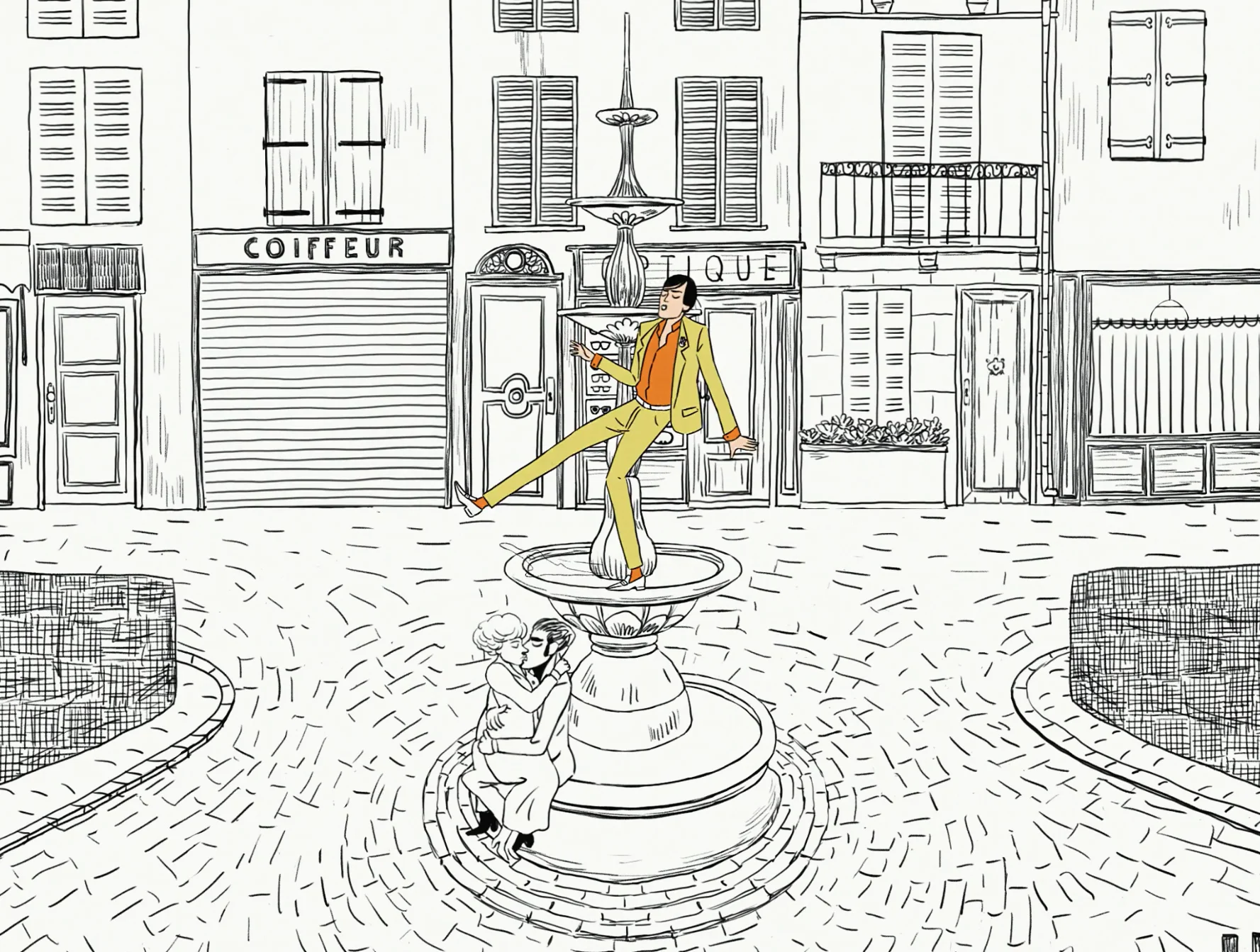
As the world waited for the release of The French Dispatch, Wes Anderson gathered a small team together to make his first-ever music video to celebrate the feature film’s theme song, Aline. Here Liv Siddall speaks to the film’s artist Javi Aznarez, Wes’ co-producer Octavia Peissel and Aline singer Jarvis Cocker about the making of Aline, life on the set of The French Dispatch and the wild combination of people that make every Wes Anderson project magical to work on.

Picture this: you’re an illustrator who prefers to work alone, quietly, in your studio, calmly drawing cartoons and answering briefs with pen and ink. Imagine then that you find yourself not only working flat out on what turns out to be a three-year-long collaboration with one of the most famous directors in the world, but also drawing live, on a film set, in front of said director and the entire crew of one of the most hotly anticipated cinematic releases of the decade.
Last year, during the making of Wes Anderson’s The French Dispatch, this situation became a reality for artist Javi Aznarez. When Wes was looking for an artist to work on the film, his co-producer Octavia Peissel suggested Javi. Wes was so taken with his work that he invited Javi to join the team in an illustration and artwork capacity.

I think Wes has a way of getting a kind of family of people together...and adds to that family as he goes along.

Javi, who agreed, was under the impression he’d be making posters for the scenery. When he arrived on set, however, Javi was handed some wall panels by production designer Adam Stockhausen, who instructed him to make it look like Hermés Jones, the fictional art director in the film, had been doodling on them for 15–20 years. Oh, and that the drawings had to be ready to be shot the next day. Armed with a lot of coffee, Javi worked through the night to get the job done. By the time the cameras began rolling the following afternoon, Javi was watching the scene, not having slept, when he was directed to come and contribute additional drawings live on set. In a sort of surreal anxiety dream, or an intense, career-defining game of Pictionary, Javi began to draw directly onto the meticulously designed, perfectly patinated walls of the set of The French Dispatch, instructed by Wes Anderson himself, while the entire crew looked on.
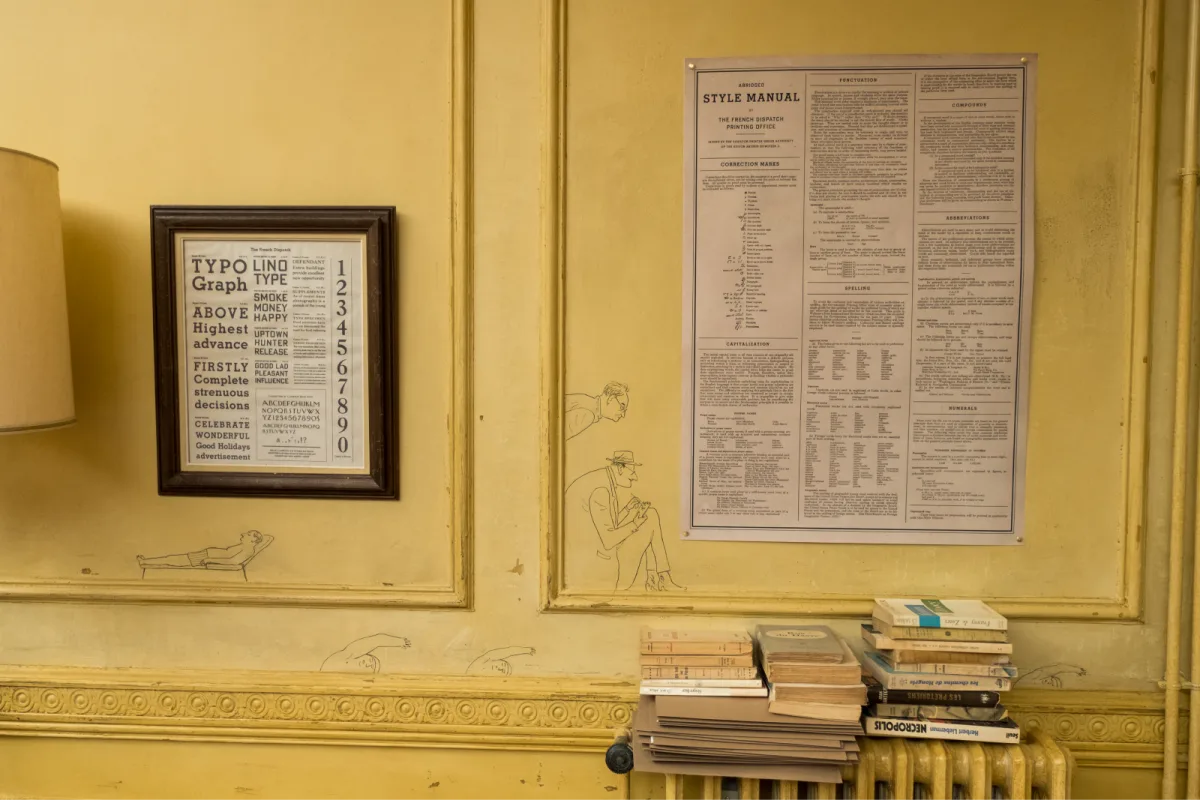
Octavia recalls that Javi kept a steady hand while he drew, but came away quivering with nerves. That experience taught him about the power of collaboration. “I learnt a lot from the teamwork aspect of working in that environment...Wes is surrounded by a fantastic team, and their problem-solving skills and ability to work through things was something I learned so much from,” Javi says. “No matter how high the pressure is on set, I had the team to rely on. It also helps that drawing is very relaxing for me! Usually, I’m quite an anxious person.”

Most of the elements come from the film itself, but anything that I had to add or invent came from my imagination and my memories of Paris.



Javi grew up between Barcelona and the nearby harbor town of Cadaqués, where he now lives and works. Coincidentally, that’s where Octavia grew up too, which is how she knew of him. Throughout his childhood, Javi survived the daily boredom of school by drawing, spending his entire academic career doodling or reading Tintin, Asterix and classic bandes dessinées, as well as devouring the output of Argentinian cartoonist Quino. When it was time to choose what to do after high school, Javi begged his parents to let him go to art school, but they refused. “They said I needed to take a more conventional career track,” Javi recalls. “But they also said that if I did this, then they’d be more open to me pursuing art afterwards.”
Javi got his head down and doodled his way through business school, passing with good grades and then hotfooting it straight to Escola Joso, a comics and visual-arts school in Barcelona, where life finally started to make sense for him. “I always saw being an illustrator or artist as something extremely difficult and complicated and out of reach,” he says. “It was only when I finally went to drawing school that I realized I could be an artist.” Since then, he’s become a highly sought-after illustrator, applying his Hergé-esque, ligne claire style to books, storyboards, exhibitions and—crucially—editorial for the likes of Vogue and The New Yorker.

Javi’s artistic style lends itself particularly well to the pages of The New Yorker. Since 1925, the magazine has staunchly championed the humble cartoonist, consistently favoring black-and-white, classically unfussy drawings for its beloved (and now trademark) spot illustrations. They’re classic. Timeless, too. You’d be hard pressed to look at all of the cartoons commissioned in The New Yorker’s history and pinpoint the year each was created. In that way, the visually evergreen nature of the magazine mirrors Wes Anderson’s cinematic style. Ask someone what year they think one of his films was set in and they probably couldn’t tell you; in the same way it’s often impossible to date a New Yorker cartoon. The important stuff is there: it’s classic, timeless, humorous. No matter the subject matter, there’s a very pleasing, familiar warmth to it.
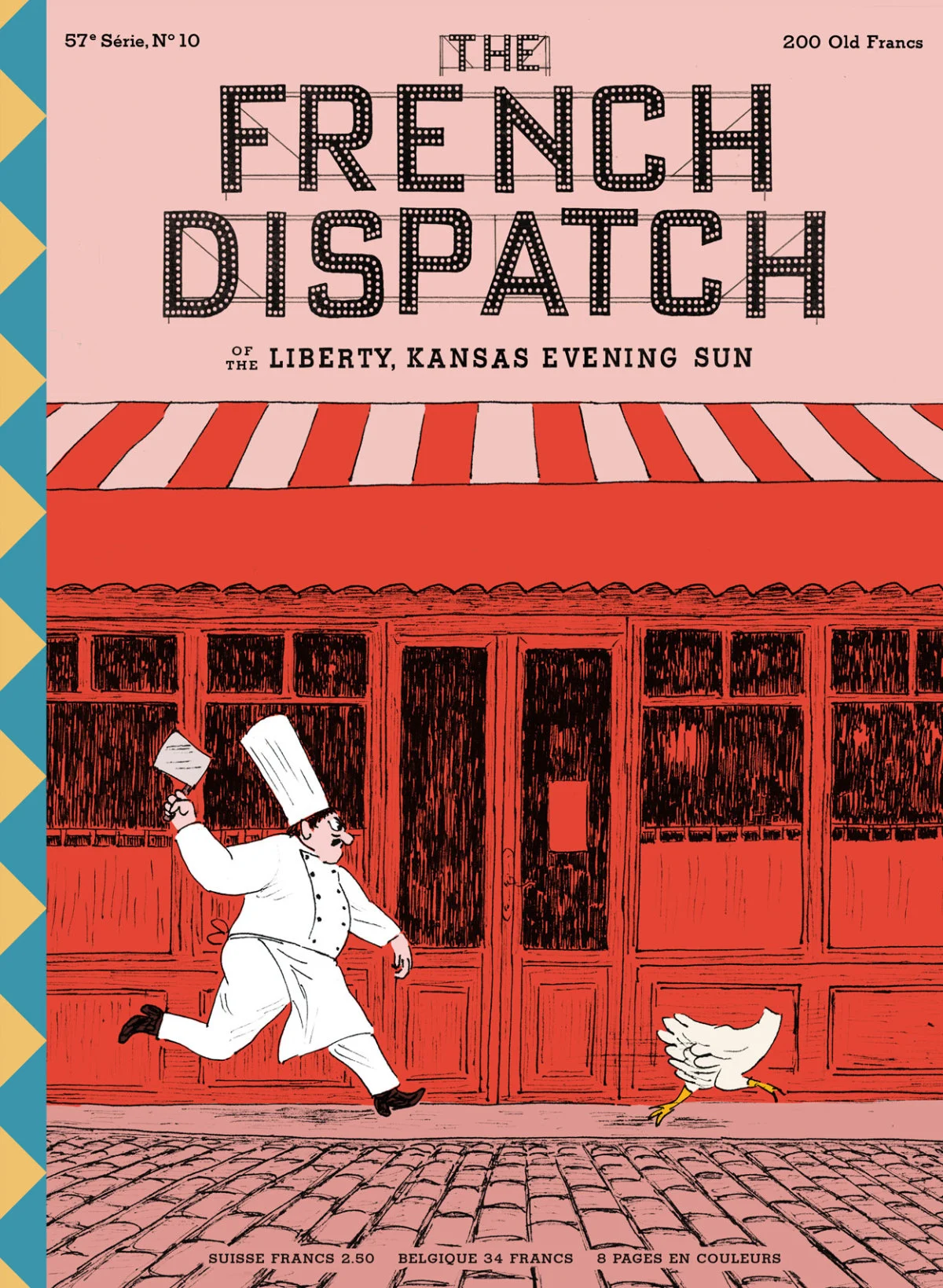
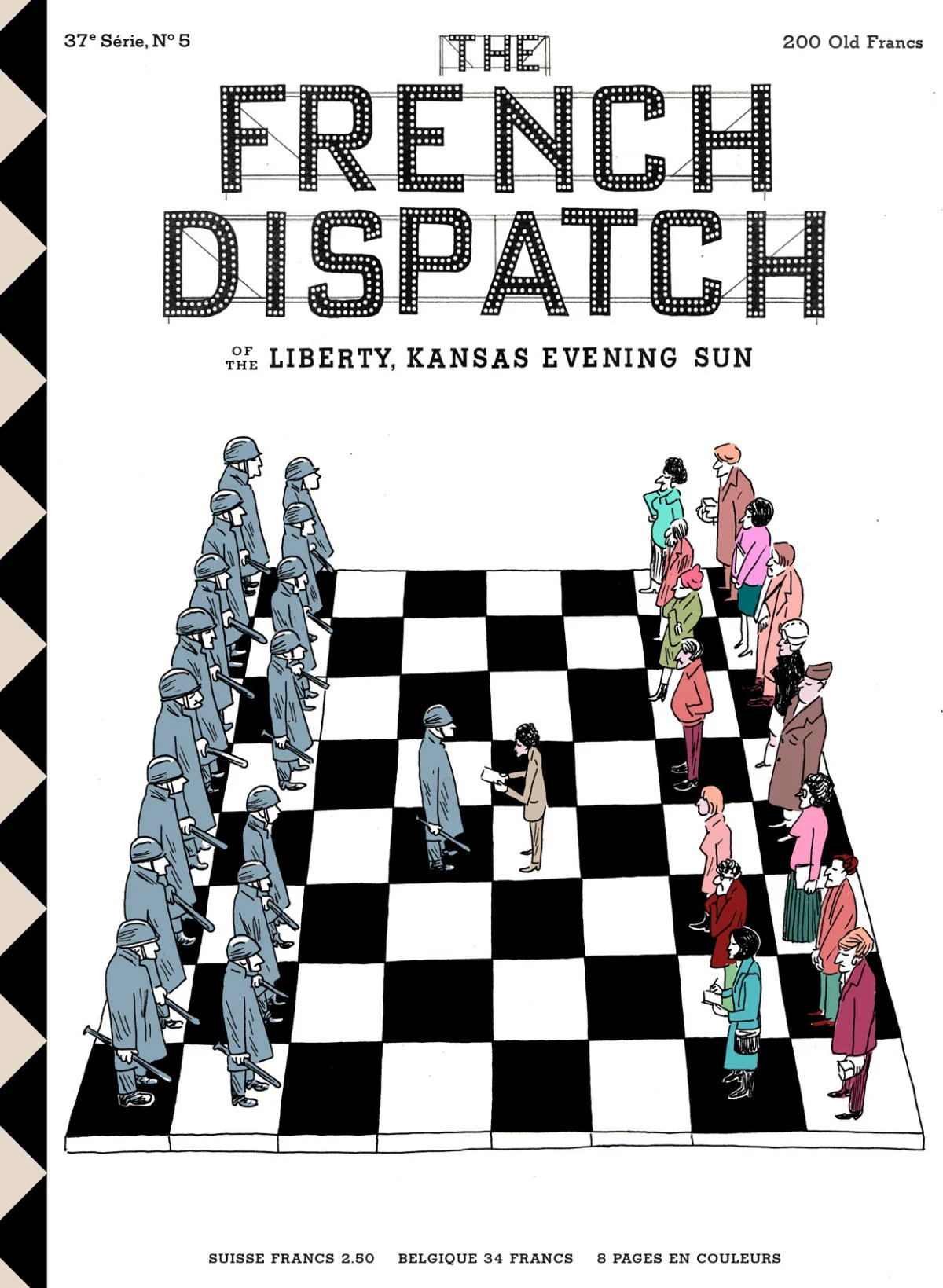


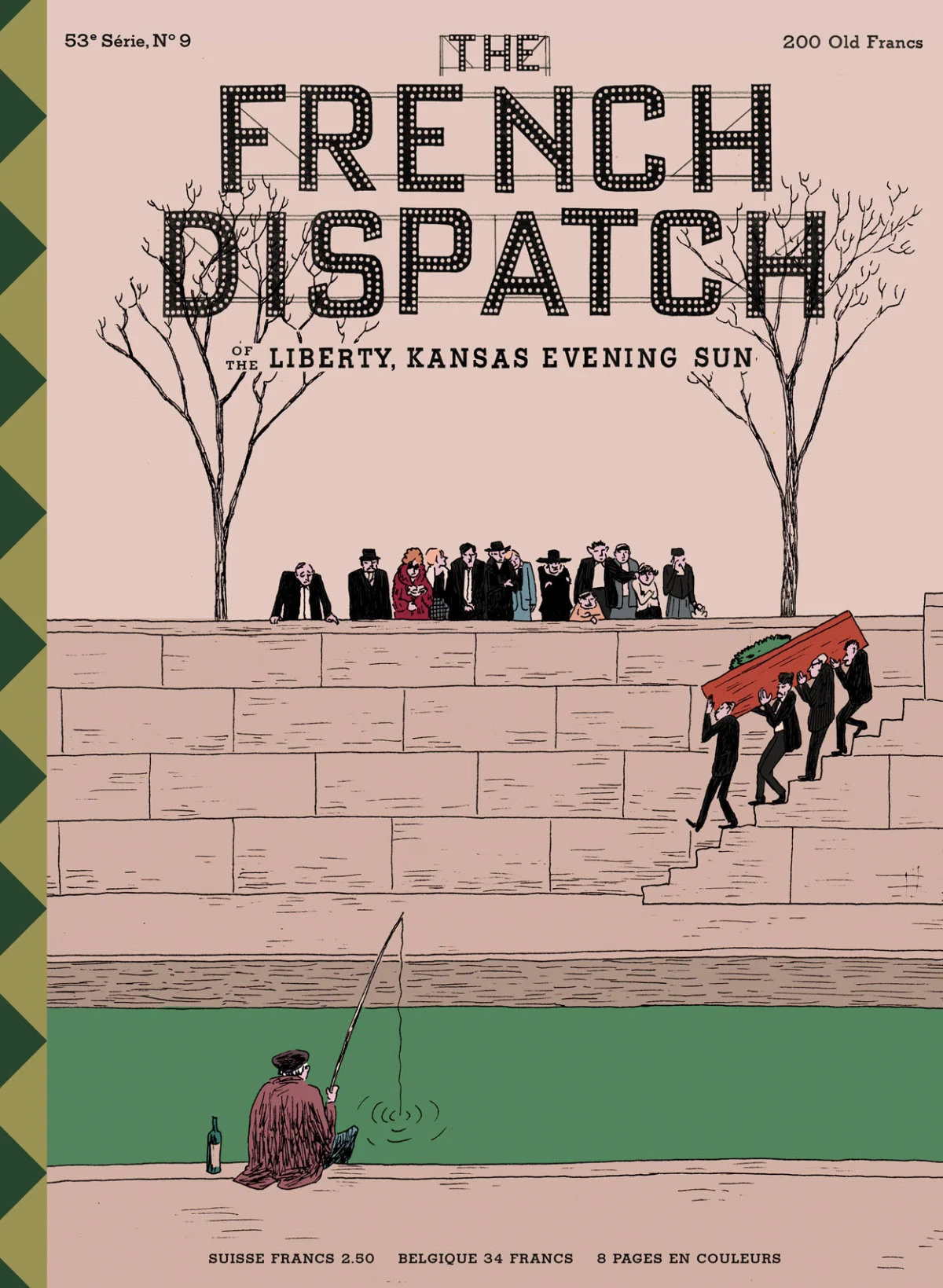

To those who are acquainted with both Wes’ films and the magazine, it will come as no surprise that he has been a lifelong New Yorker reader. In a recent article in the actual New Yorker (getting a bit meta now, bear with me) we learn that the director has “amassed a vast collection of bound volumes of the magazine, going back to the nineteen-forties.” Created as an ode to his favorite weekly, with even its characters based on real New Yorker journalists and stories, The French Dispatch is set in a fictional French town (Ennui-sur-Blasé) where the eponymous supplement to the Liberty, Kansas Evening Sun is produced. Wes was looking for an artist to work on this fictional magazine, creating its covers and drawing live on camera for scenes in which the it’s in-house artist is drawing. We know that the character of Hermés Jones doodles on the walls of his office, much like the current creative director of The New Yorker, Nicholas Blechman, allows his friend, the cartoonist Christoph Niemann, to doodle on the walls and windows of his office in the magazine’s One World Trade Center HQ.
As the film is made in homage to The New Yorker, the artist’s style needed to possess a faint whiff of the magazine’s aesthetic values. Octavia went on the hunt. “Adam Stockhausen and I were looking at all sorts of illustrators that could be considered for the role of Hermés Jones, who in front of the camera is Jason Schwartzman, but [behind the camera] needed to be an illustrator with a certain [type of] hand,” Octavia says. “Like a lot of people in Wes’ surroundings, I was already extremely familiar with The New Yorker and knew what that looked like...single line drawings that have a lot of character and observational humor.” She approached a number of artists, including Javi, who worked hard on a proposal. “Wes immediately responded really positively to [Javi’s] work,” she said. “There was no question after that.”

So Javi was brought on board to help bring Wes Anderson’s cinematic version of one of the world’s most influential magazines to life. And so enamored was Wes with Javi’s drawings that the brief began expanding—quickly. Alongside his existing brief, and the time he was putting in after hours drawing situational doodles on set (rats in the corridors, or a cartoon of a man reclining in the warm beam of light emitted by a desk lamp), Javi also worked on 30 (!) magazine covers for the end credits. Add that to a whole bunch of promo artwork (the official poster, for example) and Javi had a pretty full-on few years working solidly on the film.
During this time, Wes was busy recording a lead track for the film with Jarvis Cocker, who plays pop star Tip-Top in the film. Initially, Wes and Jarvis had written a brand-new song together but it didn’t feel quite right, so Wes asked Jarvis if he would cover one of his favorite songs, a mournful 1965 French hit called Aline, by the late, great Christophe, who inspired the character of Tip-Top. It turns out that Wes once had a run-in with Christophe himself. “The way I’ve heard it,” Jarvis explains, “[Wes] first heard the song when he was at a dinner in Paris and was sat next to this guy he didn’t know...then at some point the guy was called away and played that song at a piano...it was Christophe himself.”

Already a fan of French music from that era, Jarvis was familiar with Aline. “I think [Wes] played it to me once, but I didn’t really know it that intimately until we got into actually learning how to play it,” Jarvis says. They ended up recording the track at AIR Studios in London. “That was an interesting thing to do because Wes was there and he kind of directed my singing...I sang it a few times and he’d say, ‘Oh, maybe try it spoken in this part, and sing it out more in this part…’ so it was interesting to work with him on that.”
Wes and his music supervisor Randall Poster enjoyed the process so much that they suggested that Jarvis might like to take the Tip-Top character a bit further and do a whole record of cover versions of French songs from the 1960s and early 1970s. Jarvis agreed. The record, called Chansons d’Ennui Tip Top, will be released on the same day as the film. “Tip-Top is kind of like a fictional pop star in the film and so I suppose I like to think that we were recording his greatest-hits album,” Jarvis explains. “So that’s what we did. But really, I mean, for me, the big thing was all these French songs that I’ve loved for a long time, I got a chance to have a go with.”

Wes was extremely involved on a daily basis in every aspect of this. I think that’s what might be surprising to some people.

Wes then decided that Jarvis’ Aline cover was so good that it deserved a music video to go with it. Octavia, who is used to making special side projects around Wes’ feature films, imagined that they’d do a straightforward music video starring the actual Jarvis Cocker as Tip-Top. “When lockdown and COVID happened, my assumption was that we would either table the idea entirely, or pick it up in some distant future as something that you could shoot maybe in a day or two,” Octavia says. Wes, it turned out, had other ideas.
Wes, now confident working with animation after making his previous feature film, Isle of Dogs, suggested a hand-drawn process using Javi’s illustrations. What followed was the creation of the first-ever Wes Anderson-directed music video, which took Wes, Javi and seven other people eight months to complete.

The video features Jarvis Cocker as Tip-Top, taking us on a journey through Ennui-sur-Blasé. Along the way we meet the characters of the film and catch glimpses of the plot. We watch as Tip-Top cheerfully uses a floating corpse in a canal as a stepping stone, or dances past Tilda Swinton observing some elderly French gentlemen play pétanque. We climb up and up through the town with the boulangerie delivery vans in a way that seems to move through storeys without ever breaking the shot.
Octavia explains that if the viewer were to zoom out, they’d see “one giant fresco of the entire town” laid out. “It ended up being five portions or panels that are then stitched together,” she says, “but essentially yes, it is one giant flat town.” In that way it’s very Wes. Being led through a world, as if what is being filmed is a large diagram that a camera has honed in on and is moving around. Even though it’s animated, the viewing experience is almost reminiscent of the famous Play With Fire montage in The Darjeeling Limited or the “Let me tell you about my boat” scene from The Life Aquatic with Steve Zissou.

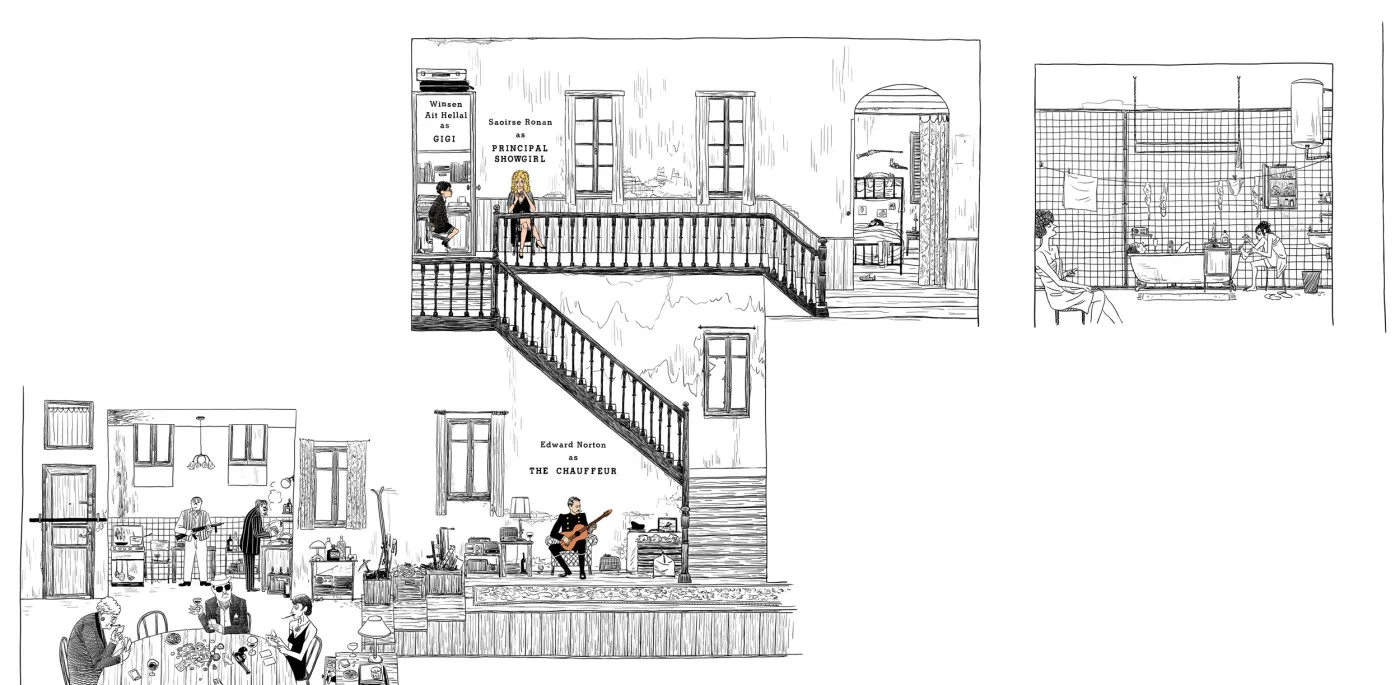
“Javi did the full layout: all of the backgrounds, all of the character design, but then for Tip-Top himself, he drew dozens and dozens of faces, movements and expressions,” Octavia says. “For the way that Tip-Top dances and moves, we used references of Jarvis himself in different videos and concerts.” As lockdown dictated that the team (sadly) weren’t able to draw Jarvis dancing from life, they did what all the best animators do and relied on a friend (or, in this case, head animator Arnau Solà) to send videos of himself walking upstairs sideways, or contorting his body into different positions, for Javi and the animators to work with. Once they had created portions of the animatic, they would send it over to Wes for feedback. “Wes was extremely involved on a daily basis in every aspect of this. I think that’s what might be surprising to some people,” Octavia says. “He was in contact with Javi almost daily, and then depending on the drawing or the action, sometimes it would make sense to constantly loop Wes into the evolution so that he could gauge and redirect.”

What’s really striking is just how French the video feels. This can be partly explained by Javi’s longstanding love of bandes dessinées, but the details in the illustrations he created for the Aline video are also the product of Javi’s own experience with the country. His wife is from Paris, he lived there for five years and he visits France a few times every year. Javi once worked on a futuristic comic set in Paris, so he had already amassed a whole load of images of the city’s architecture. “When I found out that The French Dispatch was set in a fictional town heavily inspired by historical Paris, it was great because it was a world I already knew and appreciated,” Javi says. “So, in the Aline video, most of the elements come from the film itself, but anything that I had to add or invent came from my imagination and my memories of Paris.”


It ended up being five portions or panels that are then stitched together, but essentially yes, it is one giant flat town.

When it came to bringing Javi’s drawings to life, Octavia already had some of the best animators in the business on speed dial and managed to rustle up a killer team. They had Wes directing as well, who, by this point, had two feature-length stop-motion films under his belt. “Wes has experienced posing a puppet or a character 12 to 24 times for one second,” says Octavia. “He’s no stranger to how labor-intensive it can be to tweak things in animation.”
Any fan of the way Wes Anderson and his team put together every second of a feature film will understand that the very same level of care went into this short. Even though Javi found himself drawing live on set with Wes, or drawing rats onto the scenery late into the night, he admits that making Aline was the most difficult aspect. “It was definitely the most challenging part, but also the thing I’m most proud of,” Javi says. “I can’t wait for it to come out and for people to see it, because it’s just an incredible tour de force...everyone who collaborated on it...it’s very exciting to then be able to share that with everyone.”

Jarvis Cocker agrees that it’s the sharing that makes the magic happen. “I think he’s got a way of getting a kind of family of people together...and adds to that family as he goes along. I think the reason that happens is because he makes the whole filmmaking experience a pleasure for people and he’s really immersed in film history as well, so shares that with others, too.”
Now The French Dispatch has a release date and Aline is here too, Octavia’s already on to the next Wes Anderson project. But her experience working with Javi, who she’s known for so long, has really stuck with her. “I’ve worked on a lot of different films and a lot of these projects where it’s Wes collaborating with an artist, and I just found that this was such a good match,” she says. “I think the result is just astounding, really. It’s a perfect synthesis of the world of that film, but so much of Javi, and of Wes and his characters also. It’s just a great symbiotic thing. I’m very proud to have been part of that.”

